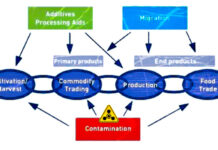Non-organic fruit and vegetables sold in the EU are increasingly contaminated by dangerous perfluoroalkyl substances, PFAS, added to pesticides. Strawberries, peaches and apricots are the most polluted fruits, reports the PAN Europe study, which summarizes a decade of monitoring.
PFAS in fruits and vegetables through pesticides
It is now known that PFAS are used in various consumer products, such as frying pans, textiles, food packaging and disposable tableware, such as those identified by recent IPEN analyzes in fast food restaurants in 17 countries. (2)
Little known instead, it is their presence in pesticides sprayed on food crops. They appear in 37 active substances approved in the European Union.
‘The PFAS have been deliberately introduced by the industry into pesticides with the addition of some fluorine atoms to increase their effectiveness, or they result as degradation by-products, such as trifluoroacetic acid (TFA), a water pollutant.
Farmers are generally unaware that they are spraying “forever pesticides” on their crops. It is not mentioned on the label‘, explains PAN Europe.
Fruits and vegetables contaminated with PFAS pesticides
The analysis on PFAS contamination of fruit and vegetables is based on the 2001-2021 collection of official monitoring data on pesticide residues in food from EU Member States. It emerges that contamination levels have tripled in ten years.
Fruit (non-organic), especially the summer one, grown in Europe is more frequently contaminated by PFAS pesticide residues, compared to vegetables:
37% of strawberries,
35% of peaches and
31% of apricots are contaminated.
– 20% of fruit contains cocktails of PFAS pesticide residues, with up to four different types detected in a single sample of strawberries and table grapes and up to three in peaches and apricots.
Overall the percentage of (non-organic) vegetables grown in Europe is 12%. But some are highly contaminated: 42% chicory, 30% cucumbers.
Of the 31 substances PFAS detected, the most frequent are the fungicide fluopyram, the insecticide flonicamid and the fungicide trifloxystrobin.
The lands of forever pesticides
In 2021, the Member States that produced fruit and vegetables most frequently contaminated with PFAS pesticide residues were
– Netherlands (27%),
– Belgium (27%),
– Austria (25%),
– Spain (22%),
– Portugal (21%).
Italy is absent from the list not because it is more virtuous, but because it is not included in the monitoring.
Between imported fruit and vegetables, the greatest incidence of PFAS pesticide residues originates in
– Costa Rica (41%),
– India (38%),
– South Africa (28%),
– Colombia (26%),
– Morocco (24%).
Highly toxic chemical cocktails
Most of the residues detected in the study is ‘in accordance with the law’, below the maximum residue limits (MRLs). However, this does not eliminate the concerns.
The safety thresholds (LMR), in fact, do not take into account the cocktail effect, i.e. the combined exposure to different chemical substances. And research has already shown that the toxic effects are real and measurable, as we have seen. (3)
Certain toxicity
PFAS substances represent a huge threat. They are known as ‘forever chemicals’ due to their persistence in the environment and are related to significant toxicity for human health.
Scientific literature correlates them with damage to fertility, fetal development and thyroid hormone function, endocrine interference, carcinogenesis, genotoxicity.
IARC, the International Agency for Research on Cancer, has classified the two best-known PFAS substances – PFOA and PFOS – as ‘carcinogenic to humans’ and ‘possible carcinogenic to humans’ respectively. (4)
Stop PFAS pesticides
It’s urgent ban the use of PFAS pesticides to curb the exposure of European citizens and protect the health of the population, including that of the most vulnerable groups, such as pregnant women, newborns and children, reiterates PAN Europe, which in November 2023 dedicated a report to the topic. (5,6)
The approval of PFAS pesticides ‘demonstrates a disregard for European legislation by allowing the use of pesticides in our food production that can harm human and animal health, as well as the environment. The persistence of these PFAS pesticides, along with their inherent toxic properties, should have led to their swift ban‘ underlines Angeliki Lysimachou, scientific and political director of PAN Europe.
Marta Strinati
Footnotes
(1) Toxic Harvest. The rise of forever pesticides in fruit and vegetables in Europe. PAN Europe. February 2024 https://www.pan-europe.info/sites/pan-europe.info/files/public/resources/reports/Report_Toxic%20Harvest%20The%20rise%20of%20forever%20PFAS%20pesticides%20in%20fruit%20and%20vegetables%20in%20Europe%2027022024%20%281%29.pdf
The report is produced by PAN Europe in collaboration with Ecocity, Ecologistas en Acción, Magyar Természetvédők Szövetsége (Friends of the Earth Hungary), Générations Futures, Global 2000 (Friends of the Earth Austria), PAN Germany, PAN Netherlands and Nature & Progrès Belgique.
(2) Marta Strinati. PFAS, the toxic chemicals in fast-food containers and tableware. IPEN investigation. GIFT (Great Italian Food Trade). 19.12.23
(3) Marta Strinati. Pesticide cocktails cause toxicity, even at the doses allowed in the EU. New study. GIFT (Great Italian Food Trade). 24.10.20
(4) Marta Strinati. PFAS substances are carcinogenic, IARC confirms. GIFT (Great Italian Food Trade). 3.12.23
(5) Europe’s Toxic Harvest. Unmasking PFAS pesticides authorized in Europe. PAN Europe. November 2023 https://www.pan-europe.info/sites/pan-europe.info/files/public/resources/reports/PFAS%20Pesticides%20report%20November%202023.pdf
(6) Marta Strinati, Dario Dongo. PFAS in rainwater and food, a global ban is urgently needed. GIFT (Great Italian Food Trade). 26.8.22
Professional journalist since January 1995, he has worked for newspapers (Il Messaggero, Paese Sera, La Stampa) and periodicals (NumeroUno, Il Salvagente). She is the author of journalistic surveys on food, she has published the book "Reading labels to know what we eat".








